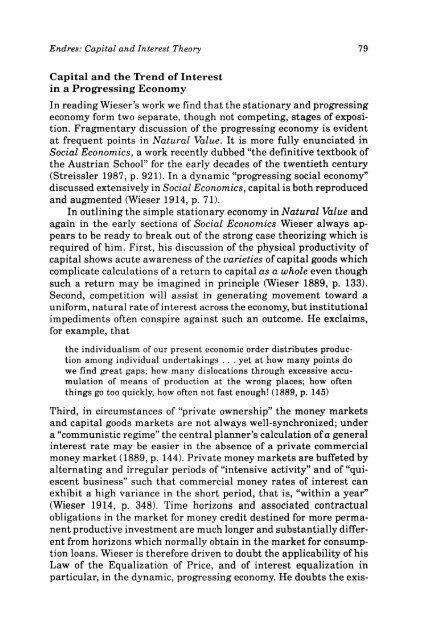Review of Austrian Economics - The Ludwig von Mises Institute
Review of Austrian Economics - The Ludwig von Mises Institute
Review of Austrian Economics - The Ludwig von Mises Institute
You also want an ePaper? Increase the reach of your titles
YUMPU automatically turns print PDFs into web optimized ePapers that Google loves.
Endres: Capital and Interest <strong>The</strong>ory 79<br />
Capital and the Trend <strong>of</strong> Interest<br />
in a Progressing Economy<br />
In reading Wieser's work we find that the stationary and progressing<br />
economy form two separate, though not competing, stages <strong>of</strong> exposition.<br />
Fragmentary discussion <strong>of</strong> the progressing economy is evident<br />
at frequent points in Natural Value. It is more fully enunciated in<br />
Social <strong>Economics</strong>, a work recently dubbed "the definitive textbook <strong>of</strong><br />
the <strong>Austrian</strong> School" for the early decades <strong>of</strong> the twentieth century<br />
(Streissler 1987, p. 921). In a dynamic "progressing social economy"<br />
discussed extensively in Social <strong>Economics</strong>, capital is both reproduced<br />
and augmented (Wieser 1914, p. 71).<br />
In outlining the simple stationary economy in Natural Value and<br />
again in the early sections <strong>of</strong> Social <strong>Economics</strong> Wieser always appears<br />
to be ready to break out <strong>of</strong> the strong case theorizing which is<br />
required <strong>of</strong> him. First, his discussion <strong>of</strong> the physical productivity <strong>of</strong><br />
capital shows acute awareness <strong>of</strong> the varieties <strong>of</strong> capital goods which<br />
complicate calculations <strong>of</strong> a return to capital as a whole even though<br />
such a return may be imagined in principle (Wieser 1889, p. 133).<br />
Second, competition will assist in generating movement toward a<br />
uniform, natural rate <strong>of</strong> interest across the economy, but institutional<br />
impediments <strong>of</strong>ten conspire against such an outcome. He exclaims,<br />
for example, that<br />
the individualism <strong>of</strong> our present economic order distributes production<br />
among individual undertakings . . . yet at how many points do<br />
we find great gaps; how many dislocations through excessive accumulation<br />
<strong>of</strong> means <strong>of</strong> production at the wrong places; how <strong>of</strong>ten<br />
things go too quickly, how <strong>of</strong>ten not fast enough! (1889, p. 145)<br />
Third, in circumstances <strong>of</strong> "private ownership" the money markets<br />
and capital goods markets are not always well-synchronized; under<br />
a "communistic regime" the central planner's calculation <strong>of</strong> a general<br />
interest rate may be easier in the absence <strong>of</strong> a private commercial<br />
money market (1889, p. 144). Private money markets are buffeted by<br />
alternating and irregular periods <strong>of</strong> "intensive activity" and <strong>of</strong> "quiescent<br />
business" such that commercial money rates <strong>of</strong> interest can<br />
exhibit a high variance in the short period, that is, "within a year"<br />
(Wieser 1914, p. 348). Time horizons and associated contractual<br />
obligations in the market for money credit destined for more permanent<br />
productive investment are much longer and substantially different<br />
from horizons which normally obtain in the market for consumption<br />
loans. Wieser is therefore driven to doubt the applicability <strong>of</strong> his<br />
Law <strong>of</strong> the Equalization <strong>of</strong> Price, and <strong>of</strong> interest equalization in<br />
particular, in the dynamic, progressing economy. He doubts the exis-

















